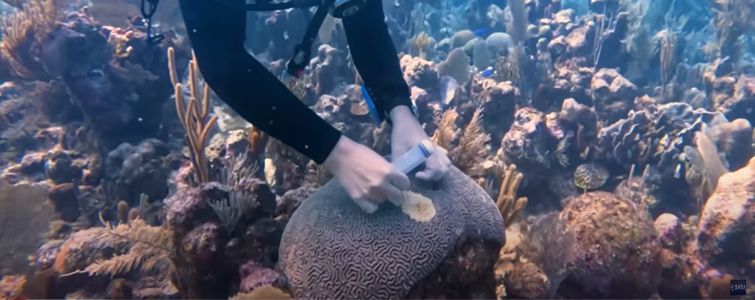 When we went on a family scuba diving trip to the coral reefs of Roatan, Honduras, we took the antibiotic amoxicillin as a prophylaxis for malaria. Scientists are now using the same antibiotic to combat stony coral tissue loss disease (SCTLD) that has ravaged coral reefs in Florida and is rapidly spreading across reefs in the Caribbean. The disease destroys the soft tissue of at least 22 species of reef-building corals, killing them within weeks or months of becoming infected.
When we went on a family scuba diving trip to the coral reefs of Roatan, Honduras, we took the antibiotic amoxicillin as a prophylaxis for malaria. Scientists are now using the same antibiotic to combat stony coral tissue loss disease (SCTLD) that has ravaged coral reefs in Florida and is rapidly spreading across reefs in the Caribbean. The disease destroys the soft tissue of at least 22 species of reef-building corals, killing them within weeks or months of becoming infected.
NOAA describes stony coral tissue loss disease (SCTLD) as a highly lethal coral disease that was first reported off the coast of Florida in 2014…The disease affects over 20 coral species and is now present on reefs in 18 countries and territories. The large geographic scale of this outbreak, high lethality of the disease lesion, and broad susceptibility among coral species make SCTLD unprecedented in its ecological impact and likely make it the most deadly coral disease outbreak in history.
The good news is that researchers are now using an amoxicillin paste to combat SCTLD in stony corals. Florida Atlantic University reports that amoxicillin treatment had a 95 percent success rate at healing individual SCTLD lesions. The less-than-good news is that it did not necessarily prevent treated coral colonies from developing new lesions over time.
There are also serious concerns that the use of amoxicillin risks promoting antibiotic-resistant bacteria. Researchers with the Smithsonian’s National Museum of Natural History, however, have discovered the first effective bacterial probiotic for treating and preventing SCTLD.
They report that the probiotic treatment, described in a paper published in Communications Biology, provides an alternative to the use of the broad-spectrum antibiotic amoxicillin, which has so far been the only proven treatment for the disease but runs the risk of promoting antibiotic-resistant bacteria.
SCTLD afflicts at least two dozen species of so-called hard corals, which provide essential habitat for innumerable fishes and marine animals of economic and intrinsic value while also helping to defend coastlines from storm damage.
“It just eats the coral tissue away,” said Valerie Paul, head scientist at the Smithsonian Marine Station at Fort Pierce, Florida, and senior author of the study. “The living tissue sloughs off and what is left behind is just a white calcium carbonate skeleton.”
The potential of this newly identified probiotic to help Florida’s embattled corals without the danger of inadvertently spawning antibiotic-resistant bacteria represents some urgently needed good news, Paul said.
“Between ocean acidification, coral bleaching, pollution, and disease there are a lot of ways to kill coral,” Paul said. “We need to do everything we can to help them so they don’t disappear.”
Thanks to Alaric Bond for contributing to this post.
